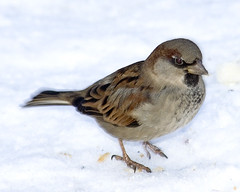The House sparrow (Passer domesticus), is a familiar species, in part because of its affinity for human habitation. The house sparrow frequently dust-bathes, and is often seen in small groups on house roofs. Where it is fed in urban parks, it can become remarkably tame, even taking food from the hand. The sexes are dissimilar.The adult male has a grey crown, cheeks and rump. The nape, sides of crown, back and wings are chest-nut brown, the underparts are pale grey and the throat and breast are black. The bill is dark and the legs are reddish. The adult female has mainly brown upperparts, including the crown, and the back is streaked with buff. The underparts are a pale grey.
The house sparrow is widespread in the UK, although scare in northern districts. The species habit of nesting in roof spaces and holes in walls, as well as taking advantage of food supplies in the vicinity of houses, means that the species tends to be clustered around villages, towns and buildings. The species has declined rapidly in the last few decades, perhaps as much as 50%, but there are still an estimated several million breeding pairs in the UK.
Reference List:
- Sterry.P., (2004) Collins Complete Guide to British Birds. Harper Collins Publishing Ltd, London.


